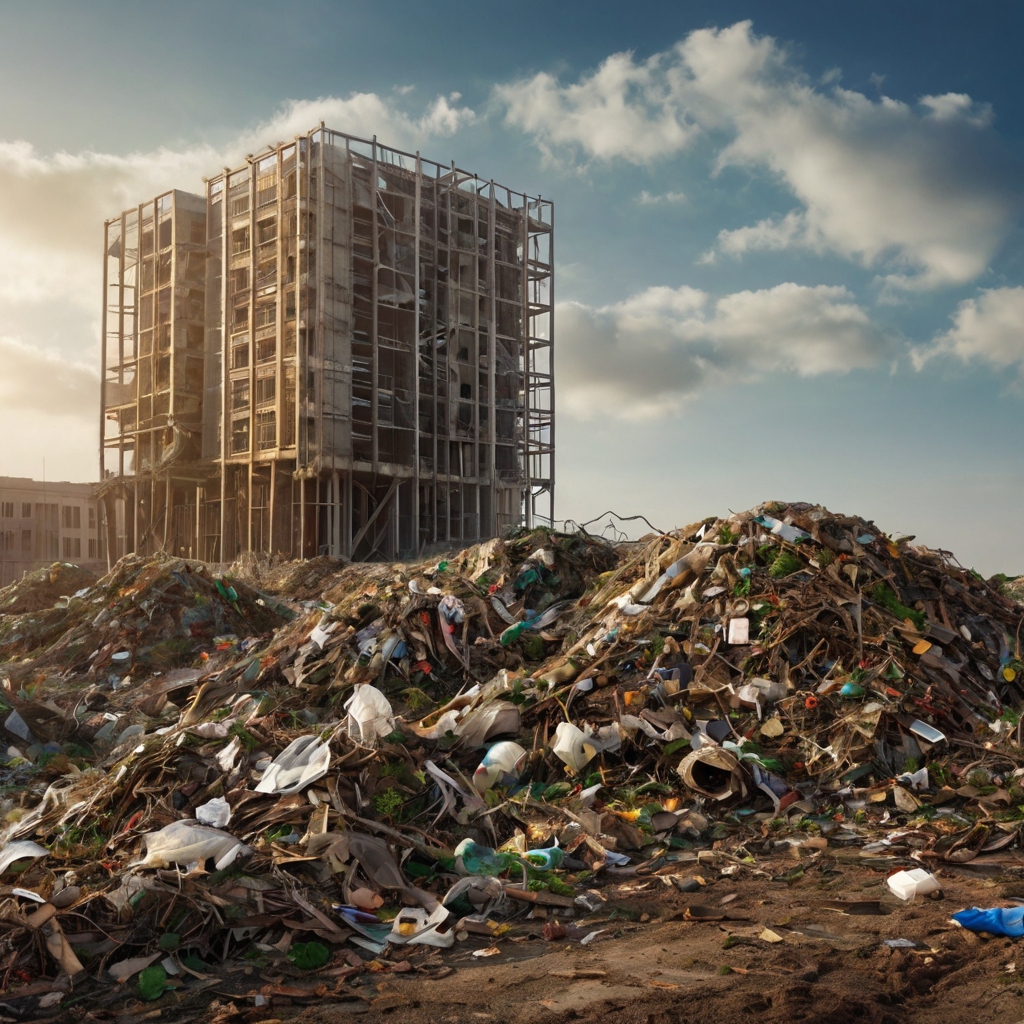Table of Contents
- 1 Key Takeaways
- 2
- 3 Why Waste Reduction Matters in Construction
- 4 Starting With a Solid Waste Management Plan
- 5 Sorting and Segregating Materials Effectively
- 6 Reusing and Recycling Materials Onsite
- 7 Embracing Technology for Smarter Disposal
- 8 Training and Accountability on Job Sites
- 9 Staying Compliant with Waste Regulations
- 10 Benefits Beyond the Bottom Line
Key Takeaways
- Efficient construction waste management leads to cost savings and a healthier environment.
- On-site sorting and material reuse are practical steps toward sustainable building.
- Modern technology and thoughtful planning enhance waste reduction efforts.
- Compliance with local regulations and industry standards supports responsible disposal.
- Adopting new practices can improve a company’s reputation and worker satisfaction.
 Why Waste Reduction Matters in Construction
Why Waste Reduction Matters in Construction
The construction sector is a major global waste contributor, with the US alone producing over 600 million tons annually. Improper waste management can clog landfills, release harmful emissions, and increase urban carbon footprint. With rising regulatory pressure and landfill fees, there’s a need for reduced waste practices. Simple, practical solutions often start with logistics, such as arranging a dedicated garbage dumpster rental for the job site. Properly sited, temporary sites provide a central, organized location for waste disposal, making it easier for teams to sort, segregate, and quickly remove refuse as work progresses. This upfront organization saves time and labor, prevents debris from piling up, and helps ensure hazardous or recyclable materials are not lost in the shuffle. The outcome: cleaner job sites, improved safety, lower costs, and a measurable boost for sustainability efforts.
Starting With a Solid Waste Management Plan
Launching a construction project without a waste management plan is a missed opportunity. A well-documented plan outlines how each type of waste will be handled from start to finish, well before heavy machinery arrives on site. This means identifying which materials are most likely to generate surplus, mapping where and how sorting stations will be organized, and setting targets for landfill diversion or recycling percentages. Adjustments are easier when this proactive approach is built into a project’s early planning stages, and site teams know what’s expected from day one. According to recent industry news coverage, projects with clear, written waste management strategies can reduce landfill disposal by up to 70%. Key components include assigning responsibility to a waste manager, ensuring clear signage for all bins and containers, planning regular audits, and building relationships with local recyclers and haulers. Plans should address potential problem areas—such as demolition phases or delivery packaging—and outline systems for tracking waste generation at each step. Simple tools like spreadsheets or checklists can keep everyone accountable and encourage ongoing improvements throughout the build.
Sorting and Segregating Materials Effectively
Sorting is the lifeblood of any successful construction waste reduction effort. When workers toss everything into a single container, opportunities for recycling or reuse are lost. Yet, when teams implement a system with distinct bins for wood, drywall, concrete, plastic, and metals, recovery rates skyrocket—and so do savings on disposal fees. Color-coding bins or using prominent signage makes it easier for everyone on site to follow best practices without having to second-guess where something belongs.
For example, providing each group with a quick sorting guide on busy sites with multiple subcontractors is helpful. Visual checklists at each waste station minimize confusion and prevent contamination, which can be a significant issue for recycling partners. Additionally, conducting brief training sessions at the start of each primary phase ensures new team members understand expectations. As habits form and workers see firsthand how easy onsite separation can be, overall efficiency and cleanliness improve. Ultimately, the goal is for sorting to become as automatic as wearing a hard hat or clocking in at the beginning of a shift.
Reusing and Recycling Materials Onsite
Not every piece of construction debris should be destined for the landfill. Creative reuse is thriving on modern job sites, and many types of materials are prime candidates. Broken concrete from demolition can be crushed and used as base material for roads, paths, or new slabs. Leftover bricks find second lives in landscaping or low walls. Scrap lumber can be repurposed for temporary forms, bracing, or blocking, reducing the need for fresh cuts.
- Concrete and masonry: Crush and use as aggregate for onsite fill or base.
- Lumber: Ideal for blocking under scaffolds, shims, or temporary walkways.
- Metals: Collected cleanly, metals retain resale value and are highly recyclable.
- Packaging materials: Pallets and cardboard are often reusable or easily recycled separately.
By setting up a dedicated “reuse zone,” project managers encourage teams to set aside and inspect offcuts and “leftovers” before tossing them into a dumponsitever the course of a project; these small, mindful steps can divert tons of material from landfills. For instance, even saving door frames or fixtures for Habitat for Humanity or similar reuse organizations can multiply onsite and create a ripple of social good beyond the site fence.
Embracing Technology for Smarter Disposal
The digital revolution is transforming every aspect of construction management, including waste reduction. Specialized apps now enable supervisors to document the type and volume of daily waste and snap photos for project records or compliance logs. Advanced project management platforms can integrate recycling tallies, providing real-time insight into landfill diversion progress. Some teams are piloting dumpsters equipped with fill-level sensors and connected to cloud dashboards; these solutions help optimize dumpster pickups, ensure space is always available, and reduce unnecessary trips. Drones offer another layer of visibility, enabling quick surveys of job sites for clutter or overflow, particularly on large-scale projects. With accurate information, site supervisors can respond swiftly to avoid bottlenecks or unsafe conditions. Digital documentation also comes in handy for regulatory reporting or when a client requests evidence of a project’s sustainable credentials. As the construction sector embraces these innovations, waste management becomes less of a manual chore and more of a streamlined, data-driven value add.
Training and Accountability on Job Sites
Even the most advanced plans and tech tools are only as good as those using them. That’s why comprehensive training and clear accountability are crucial. Every worker—from general laborers to subcontractor supervisors—should receive simple, hands-on guidance on the site’s waste reduction protocols. This extends from sorting responsibilities to understanding why these actions matter for safety, cost control, and environmental stewardship. Some projects introduce friendly competitions between crews, reward high-performing teams, or post progress charts on site noticeboards to drive participation. These practical motivators foster a shared sense of ownership, making cleanliness and efficiency a point of pride. Equally important, regular walk-throughs and audits by designated “waste champions” keep everyone engaged and ensure lapses are corrected quickly. When site culture prioritizes accountability, sustainable waste practices become second nature, and even new hires quickly get on board.
Staying Compliant with Waste Regulations
Construction waste disposal is governed by a maze of local, state, and federal laws, which change often and can be strictly enforced. Fines for improper handling, failing to recycle certain materials, or misreporting outgoing waste can quickly erode profit margins or cause costly project delays. To avoid these pitfalls, staying informed about the latest rules for each project jurisdiction is critical, and using trusted resources like EPA construction guidelines for up-to-date best practices.
- Track and document all outgoing waste by type, volume, and destination.
- Maintain organized files for receipts, permits, and compliance records.
- Chat regularly with local waste transporters, recycling centers, and hazardous material handlers for changes in policy or capacity.
Scheduling internal compliance checks at key build stages provides a safety net, catching potential issues before they attract regulatory scrutiny. Solid documentation and good communication with disposal partners ensure every load is managed responsibly and recycled, repurposed, or disposed of correctly.
Benefits Beyond the Bottom Line
The actual benefits of innovative construction waste management extend far beyond cost savings or regulatory compliance. Sites prioritizing cleanliness and organized waste sorting are safer for workers, with fewer tripping hazards and a lower risk of fire or injury. This translates directly into higher morale, improved productivity, and less downtime from accidents or clean-up emergencies. Moreover, clients and community members often note job sites that are well-kept and visibly recycling. Such professionalism can be a selling point for winning future business or building goodwill with neighbors. Environmentally, every ton of waste recycled or reused instead of buried makes a tangible impact—conserving natural resources, reducing greenhouse gas emissions, and lessening the load on overflowing landfills. In the current era of climate awareness, these efforts help chart a path toward a more resilient, responsible construction industry—one project at a time.


